"......and so to Australia!"
Probably inheriting much from his mother, Francis proved a considerable handful from the first steps he was able to take! As he grew up, his behaviour became more outrageous and the stories of problems he caused his socially conscious parents are legion.
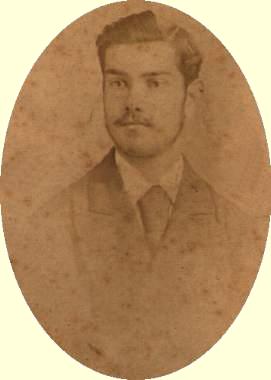 |
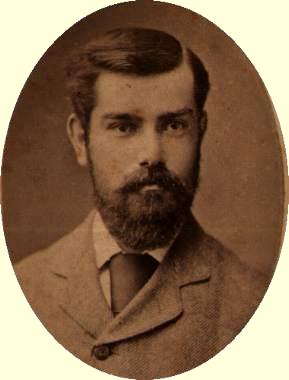 |
| Francis Bartlett at 18 years | Francis Bartlett at 23 years |
|---|
However the culmination of it all came early in the year 1875 when, as a twenty-year old student of medicine at Torbay Hospital, Francis was confronted by his latest youthful female diversion with the news that she was pregnant ...and he the guilty party!
Faced with yet one more show-down with his parents - this time something likely to prove rather more disastrous than other misdemeanours of the past - he decided the only thing to be done was to make a hasty departure for Australia, and take the girl, Louise Spicer, with him. Whether that was actually his wish we do not know it seems more likely he would have preferred to go alone but she threatened to tell his parents if he did not take her.
It says much about young Francis that, taking only what they could each carry and such small amount of money as could be collected without causing suspicion, he spent this on a second class saloon passage for himself ....whilst arranging steerage passage for poor Louise under a Government scheme to get healthy, young unattached females. He did, however, manage to get both of them on the "Star Queen" bound for Maryborough on the Queensland coast north of Brisbane although the discomforts (or worse) of the long voyage led to Louise losing the child.
The extraordinary lives these two young people then lived in, Maryborough, and further north again at Bowen where Francis practised as a doctor before adding trading in precious metals and gems to his activities, have been told in some detail in the separate account entitled "A Prescription for Success" and will not be repeated therefore in this history. However, it must nevertheless be explained that Francis very soon realised the enormous potential for professional photography in Australia, where nothing of the sort then existed, and persuaded his younger brother Henry, an amateur enthusiast back in England, to bring out the very latest equipment and join in a partnership with it's first studio in Melbourne about 1878.
 |
| Henry Charles Bartlett [Photo taken by Francis about 1883 with dry plate in 5 seconds] |
|---|
By that time brothers Hugh and William owned a corn-chandling business in Torquay, Frederick was a veterinarian, whilst Robert and Henry were both 'gentlemen of leisure' living off their father!
Following the arrival of Francis & Louise in Australia -and perhaps encouraged by his written reports of the opportunities to be found there - Louise's brother also made the voyage with his young wife. Their son, John Spicer became a well-known political figure in the Commonwealth Government, was elevated to the peerage as well as being a King's Counsel, was made a Chief Judge and in later life conducted the much criticised Inquiry into the sinking of the destroyer "Voyager".
That the long standing friendship with Pauls had endured is shown by the marriage of William to Nora Gertrude Paul, daughter of John Dommett Paul, by then living at Waterston. Daughter Emily remained an eccentric spinster, living alone with an aged parrot and known to all at Paignton by the flaming red wig she wore until her death.

In Australia the brothers' first studio was an instant success, with Melbourne's wealthy "squattocracy" lining-up to have their family photographs taken ...and the Bartlett's' bank accounts grew accordingly! So fast in fact that another studio soon opened in Bendigo (where gold riches were waiting), and then followed by yet another at sister town Ballarat.
Excerpt taken from "Photography in Australia":-
BENDIGOBendigo followed much the same pattern as Ballarat, and was not ready for an up-to-date studio until 1880 when the Bartlett Bros. (Francis and Henry) who bad conducted a successful business in Melbourne for many years opened a small studio there. It was such a success that they decided to build large modern premises, and Francis made two trips to England and the Continent for the latest ideas. In 1884 Henry died, and to replace him, Francis secured the services of Robert W. Bugg, then employed by Foster & Martin (both pupils of Batchelder's) in Collins Street, Melbourne. In that studio Bugg made some fine portraits of Anthony Trollope during the novelist's long tour of Australia. Francis Bartlett was a keen business man, and Robert Bugg was a great operator and a fine painter. Together, their success was quite outstanding. Fifteen years later Bartlett retired with a fortune, and Bugg took over the studio. Robert William Bugg, one of our leading Painter-Photographers, was born in London in 1853, and came to Melbourne when he was five years old. He became a pupil of Louis Buvelot and, in 1879, a member of the Victorian Academy of Arts. In Bendigo he gave annual exhibitions of his oils and water colours, a number of his exhibitions being officially opened by his friend Alfred Deakin. There are a number of Bugg's Paintings in the Bendigo Art Gallery. All the portraits, landscapes, buildings, and city views illustrated in "Bendigo and Vicinity, 1897", are from photographs taken by Robert Bugg. He was a clever, genial and popular soul, and his influence on the cultural life of his adopted city was considerable. He retired in 1932 and died in his early eighties. |
As well as making trips back to Europe to obtain new equipment, Francis also had three young Australians trained there in the latest photographic techniques, and then opened yet another studio in Hay Street, Perth - still the best in the Southern hemisphere as recently as 1978 - where he also purchased several tracts of prime land.

[courtesy of Tom & Libby Luke]
Bartlett Bros Studios in Williamson Street Bendigo Victoria.
In 1884, Henry died and was buried in Bendigo, after which Francis backed another winner with his engagement of the eminent portrait painter and Royal Academician, Robert W. Bugg, so that photographic portraits coloured and signed by Bugg could be offered to those wealthy enough to pay what the studio charged.
With Louise tired of the isolation of Bowen, son Robert with his law degrees and three daughters Ida, Mabel and Ethel ready for marriage, they all returned to England in 1899 with a large fortune.
Seeking the life of "country gentry" they straight away acquired the 3000 acre estate and mansion known as "Treburzy" near Launceston, Cornwall, from the banking family of Gurney, where all went well for a while with Francis able to shoot and fish and Louise enjoy the regular shooting parties invited to stay with them. However, it all soon disappointed Louise who probably wanted the lively social life, and another move was made to Paignton, close to Torquay, where "Glenarm" was purchased and Louise was able to drive around in her carriage, play whist, and generally show those who remembered her how her life had been a success in spite of it's scandalous start!
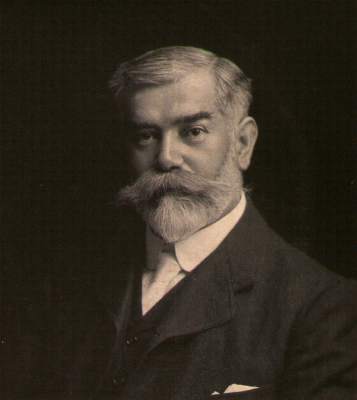 |
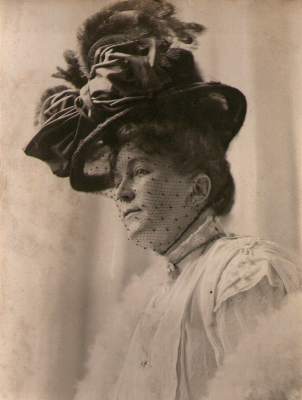 |
| Francis Bartlett | Louise Bartlett (nee Spicer) |
|---|
Francis sailed regularly back and forth to Australia and New Zealand - he made the round trip 24 times in his life - whilst continuing to shock the locals and especially those Louise wanted to impress. As the result of this he became a very well known figure around the place to be pointed out to others who did not know of his exploits. One of these that achieved a deal of publicity because it involved a well known public figure in Government, took place at a shoot where the then Lord Hailsham insisted in moving forward from the line of guns in order (as he thought) to get first and best shot at birds being 'put up' by the beaters. After warning our noble Lord of the dangers and breach of etiquette of what he was doing, Francis finally lost patience when it became clear it was going to continue ...and put a charge of bird-shot in the offender's back-side!
Needless to say, this was not happily received and after much litigation Francis paid a fairly handsome sum in compensation, but then boasted publicly that it was the best spent money of his life for the amusement it had given those who witnessed it!
Always a man who did things in his own way and at his own time, but prevented by advancing years from indulging in the shooting and fishing that he had always loved, Francis decided the time had come to call it a day in 1944 whilst the war with Germany and Japan was still going on. After swallowing a sleeping draft and having turned on the gas at the fireplace, he sat at the desk in his study and composed a letter addressed to the coroner at his own inquest!
He explained that he had enjoyed a long and eventful life during which he had done all the things he wished but was no longer able to indulge in; he made the point that under wartime conditions as they then were, such food as he was consuming would be better directed elsewhere and emphasised that the coroner should not make a finding of 'suicide whilst of unsound mind' ...because what he was about to do was both sensible and eminently practicable!
When found he was dressed as immaculately as ever in a hounds--tooth suit, silk shirt and tie ..and wearing the fawn spats he had always insisted upon.
Louise died well before Francis in 1935 when he brought his Melbourne housekeeper, a Miss Abrahams ("Dora") over to England to look after the Paignton establishment, but then insisted that she return to Australia at the outbreak of the war. She was given the Melbourne house and at his death received a quarter of his estate. He once more displayed not just his individuality but a remarkable sense of what was just and fair.
It remained with son Robert to carry on the family name and having married a Torquay girl, Evelyn Haines, whose parents owned a private hotel on Babbacombe Heights, the couple proceeded to fulfil this responsibility with considerable success.
Shortly after arriving in England in 1899, Robert who had law degrees completed in Australia, opened a practise at 32 St. James', London, in conjunction with a local one in West Norwood, then a quiet outer-suburb that still retained something of a country atmosphere, with Lord Brockwell living at Brockwell Park.
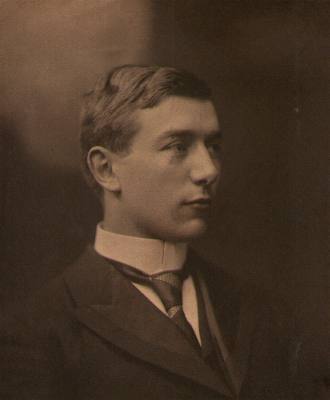
Robert Hamilton Bartlett as a young man.
Robert and Evelyn had nine children in all, although one girl died soon after birth with others being born and baptised as follows: Frances (5.10.1902), Kathleen (31.10.1903), Muriel (11.12.1904), Robert (23.5.1908), Frank (11.7.1909), John (7.5.1913), Peter (18.8.1918) and Pamela (9.11.1923).
Robert's father Francis could see the potential for property development in the district and progressively bought and later sold profitably a number of large houses with extensive grounds, into which Robert & Evelyn moved and then occupied until such time as the expected prices could be obtained. Where these once stood are now the Regal Cinema, a Shell filling station, garage and car parking facility, a super-market, and two blocks of flats etc.
The lives of Robert and his family have been fully covered in a separate narrative titled "Grains of Sand" written by the compiler of this history (son Peter) but it should be recorded here that the youngest child, Pamela, died suddenly and unexpectedly when aged only thirteen, the other three girls each married and had children, as also did the boys - although the eldest '"Bob" insisted on going to Australia at an early age. Arriving there, and despite offers of a career by his godfather, Lord Vestey, Bob chose to make his own way; after his wife Vera inherited a grazing property on the Atherton Tableland in Queensland, their large family ensured the Bartlett name became well known in the area.
All four sons served in the armed forces during the 1939/45 war Bob with the Australian Army, in the fiddle and Far East, Frank with the Parachute Regiment (Red Berets), John (finally accepted for service in spite of his earlier serious injuries) with the Army Catering Corps in North Africa and Italy, and Peter with the Queen Victoria's Rifles at Calais where he was wounded and taken prisoner. Curiously, all four sons had their left ears severed or otherwise mutilated ...and all had them then either sewn back on or reconstructed!
Whilst both Peter and Frank followed the example of their grandfather and elder brother and went to live in Australia after the war, John who married Kathleen Golding chose to remain in London where he continued a career as a chef to become Principal at the highly respected Grosvenor Hotel in London before joining International Nickel from which he finally retired - dying in 1988 and leaving a single son, Martin, with a grandson traditionally baptised Robert after his great grandfather and ancestors and a granddaughter Sara.
Frank married Mary Webb, and made their home in Brisbane, Queensland after arriving in Australia in 1960 with their two daughters and three sons. At the time of writing their family is strongly represented in a variety of occupations and professions.
The youngest son of Robert and Evelyn, Peter, married a long-time sweetheart, Gwendoline White, when in 1939 he was included in a small party of "volunteers" (!) detailed to be sent to Finland to help the Finnish Army repel the invasion of their country by the USSR. After their long separation from 1940 to 1945, the couple lived for a while near Eastbourne in Sussex before moving to London where Peter had returned to his position on the staff of the Royal Bank of Scotland, New Bond Street.
However, finding difficulty in settling back into the routine of clerical duties - and always conscious of the stories told by his grandfather, Francis, about the country, Peter decided that he and his family should make the transition; with their three young children - Lesley, Mervyn and Adrienne - they made the voyage in the S.S.Strathnore in 1956-to Australia.
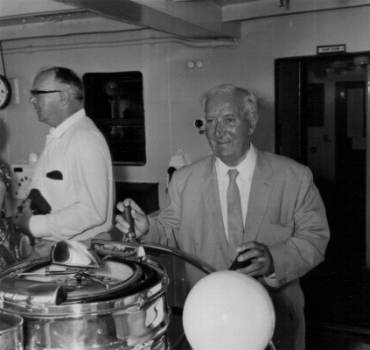
Robert Hamilton Bartlett, "at the helm" of the P&O Canberra on
a trip he and
his wife, Evelyn Rose, took to see their sons in Australia in December
1963.
Immediately upon arrival, and acting upon advice given by Peter's father, they set out once again to travel the two thousand miles north and then west to the newly discovered uranium deposits near the border of Queensland with the Northern Territory. At first, appointed Registrar by the Mary Kathleen Uranium Ltd., but later promoted to Industrial Director at the mine, and able to capitalise on the national and international publicity given to the venture, Peter was later able to make a comfortable change to the staff in Brisbane of the United Graziers' Association as it's court Advocate and then later again became the founding director of the Australian Meat Exporters Council, from where he retired in 1983.
After retirement, Gwen and Peter moved from Sydney to live near the peaceful country town of Wauchope, close to the coast two hundred and fifty miles north of Sydney, in a house they named '"Pendomer" after the Somerset manor where Bartletts had lived for so many generations, and there began raising calves as a hobby. In the brick entrance to the gravel drive up to the house is set the sandstone sculpting of St-Roch standing in the pulpit and reading from the Holy Bible that had originally formed part of the entrance to St. Roch church back in Pendomer in the year 1129.... still welcoming the Bartletts in another land!
......AND SO, having all too briefly traversed the path of the Bartletts of Pendomer through the eleven hundred years that have passed since the death of the first to bear the family name, those that can lay claim to it now will shortly be entering a new millennium.
With only a single male Bartlett member of our particular descent presently living in England - and he, Robert, perhaps destined to make his home in Norway, the country where his wife was born - the future of our line seems likely to continue in Australia where so many of the latest generation have been born.
However, before bringing to an end this account of what has been uncovered of our family's long history, it must be remembered that there are many other similarly descended Bartletts whose ancestors can be traced back to some point at which their forbears became separated from ours. Such a one is Sir John Bartlett, Baronet, of Hardington, who is descended from Joseph Bartlett, born 1761 and brother of Robert Bartlett who married Dorcas Rendall - both of Pendomer. Another is Dr. Robert Mesley of Cranleigh, Surrey, a descendant of the family of Bartletts that left Litton Cheney in the 16th century to go to Purse Caundel.
In the course of research for this project the compiler has had the great satisfaction of corresponding and in some cases meeting with members of the Paul, Kellaway, Guppy, Genge and Partridge families here in Australia and elsewhere ...and even with Bartletts in U.S.of A. whose origins were at Piddleton, Dorset.
It is the hope of the compiler that those who follow as members of the family will find it's history as fascinating to read as it has been to research and write.
| Completed at "Pendomer", New South Wales, in the year: One thousand, nine hundred and ninety-four. |
| End. |